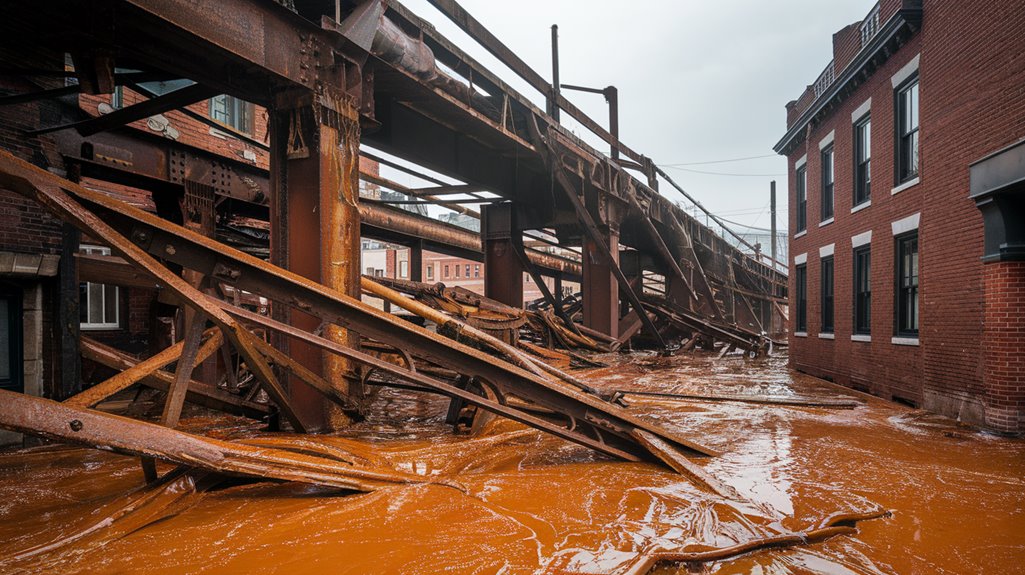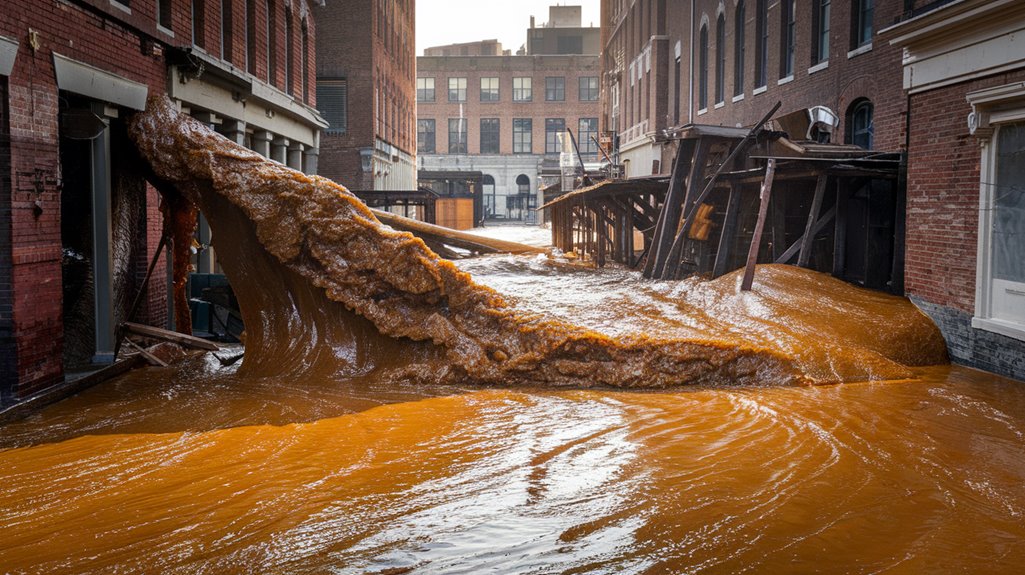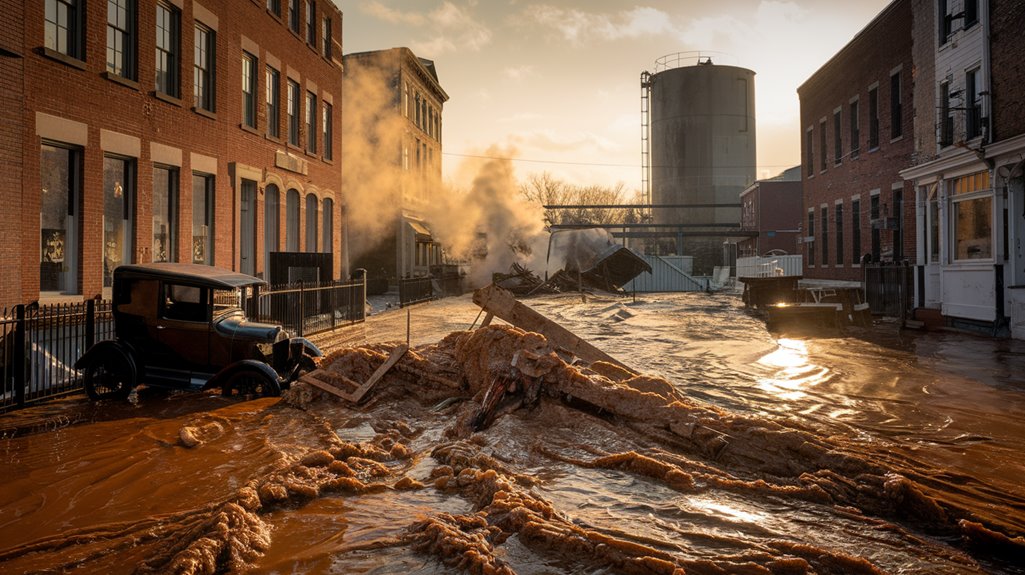A Massive Wave of Molasses Flooded Boston in 1919
You might think molasses is just a slow-moving sweetener, but in 1919 Boston, it became a deadly force of destruction. When a massive steel tank burst on a chilly January day, it released a 25-foot wave of sticky darkness that swept through the North End at 35 mph. This industrial disaster didn't just claim 21 lives and injure 150 people – it exposed dangerous corporate negligence and forever changed how we approach industrial safety in America.
The Day Boston Drowned in Sweetness

Chaos erupted in Boston's North End on January 15, 1919, when a massive steel tank burst, releasing a deadly wave of molasses through the city streets.
You wouldn't believe the terrifying speed of the 25-foot wave, which raced at 35 mph through the neighborhood, crushing everything in its path. Buildings crumbled, a streetcar toppled, and both people and animals found themselves trapped in the sticky deluge. Initial rescue operations included 116 cadets from the USS Nantucket who rushed to help the victims.
Beyond the molasses myths that have grown over the century, this disaster taught serious historical lessons about industrial safety. The catastrophe claimed 21 human lives and injured 150 others, mainly through suffocation and drowning.
As temperatures dropped, the molasses thickened, making rescue efforts nearly impossible. The United States Industrial Alcohol company initially tried to blame the disaster on sabotage rather than taking responsibility for the faulty tank. Even today, this unprecedented disaster shapes Boston's identity and serves as a stark reminder of the importance of proper industrial regulations.
How a Steel Tank Became a Deadly Weapon
While the massive steel tank in Boston's North End seemed impressive when built in 1915, its hasty construction by Purity Distilling Company held fatal flaws from the start.
The tank design was fundamentally flawed – its walls were too thin to contain 2.3 million gallons of molasses, and the chemical composition made them prone to cracking.
Despite obvious public safety concerns, including visible leaks and ominous rumbling noises, the company chose to ignore these warning signs.
A sudden temperature increase from 2°F to 41°F contributed to the catastrophic tank failure.
Instead of addressing structural issues, they painted over the leaks as a cosmetic fix.
You'd think storing millions of gallons of molasses in a densely populated area would warrant careful engineering, but the tank's operators prioritized profit over safety.
This negligence transformed an industrial storage unit into a ticking time bomb that would eventually claim 21 lives.
When Molasses Turned Deadly: The Human Cost
On January 15, 1919, a wave of molasses 25 feet high ripped through Boston's North End at 35 mph, leaving a trail of destruction that would claim 21 lives and injure 150 others.
The victim experiences were horrific. You'd have heard a strange staccato sound followed by a dull roar before the sticky flood engulfed everything in its path. Most victims were laborers and drivers, including two 10-year-old children and a firefighter, who died from suffocation under the syrup. Elizabeth O'Brien and Mary Keenan were among the lucky ones when USS Nantucket sailors rescued them from a collapsed building. The desperate search for victims continued for months until the last body was found four months later.
Survivor Martin Cloughtery woke up submerged in molasses, desperately fighting to save his sister.
Rescue efforts proved challenging as sailors from USS Nantucket and Boston police waded through knee-deep molasses to reach victims. The sticky substance covered everything, making it nearly impossible for people to escape or rescuers to navigate the disaster zone.
The Science Behind the Sticky Catastrophe
Beneath the tragic human toll of Boston's molasses disaster lay fascinating scientific principles that explain its devastating power. The catastrophe hinged on the interplay between temperature effects and compromised structural integrity.
You'd be surprised to learn that the molasses was about seven to nine degrees warmer than Boston's cold air, creating ideal conditions for rapid flow. The company's practice of painting the tank brown to hide visible leaks foreshadowed the impending disaster.
Think of it like this: The tank's steel was too thin and lacked manganese, making it brittle and prone to failure. When the structure finally gave way, it released a 2.3-million-gallon wave of warm molasses that reached speeds of 35 mph.
The disaster's impact on food culture parallels how modernist literature examined the relationship between sustenance and society's anxieties.
As the sticky liquid hit the cold winter air, it quickly thickened, trapping victims in its increasingly viscous grasp. Harvard researchers later proved these dynamics using scale models and cold corn syrup experiments.
Justice and Accountability in the Aftermath

After the molasses flood devastated Boston's North End, the quest for justice proved nearly as challenging as the cleanup itself.
You might be shocked to learn that USIA's defense attorney tried to blame Italian anarchists for the disaster, while Chief Justice Bolster's investigation deflected blame from corporate negligence.
The steel tank used to store the molasses was dangerously thin and structurally unsound.
The local community spearheaded efforts to remove hazardous industrial structures from their neighborhood.
Despite these obstacles, public pressure led to a groundbreaking class-action lawsuit.
After six years and testimony from over 3,000 witnesses, USIA was found liable in 1925. The company paid $628,000 in damages, with victims' families receiving about $7,000 each.
More importantly, this case sparked widespread regulatory reform, establishing new safety standards for corporate operations.
The disaster's legacy lives on in modern business regulations, proving that sometimes it takes tragedy to create meaningful change.
 temperatures near 50 degrees that unusually warm January day as the disaster unfolded.
temperatures near 50 degrees that unusually warm January day as the disaster unfolded.
You'd have seen USS Nantucket cadets, police, military personnel, and Red Cross nurses working tirelessly to save lives and restore order. A makeshift hospital was quickly established to treat the 150 injured victims.
The urban redevelopment that followed transformed the disaster site into what you'll now recognize as Langone and Puopolo Parks. Though the sweet smell lingered for decades, Boston emerged stronger, with stricter construction regulations and improved building oversight.
Today, a memorial plaque stands as a reminder of both the tragedy and the city's remarkable recovery, while the disaster continues to captivate researchers and historians alike.










